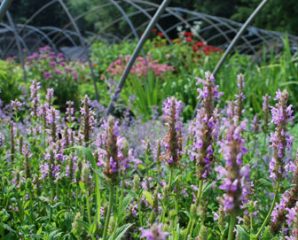Dan has added an exciting list of new perennials this year including this Catmint. We’ll be highlighting them over the next few weeks because, after all, who doesn’t want to try something new?
Chrysogonum virgatum ‘Pierre’ (Green and Gold)- Bright green foliage and yellow daisy-like flowers on this native perennial. It slowly spreads creating a nice groundcover for a partial shade or woodland garden. Plant with Hakonechloa m. ‘Aurea’ or Carex siderosticha ‘Banana Boat’ for contrast. (See below under the Plant ID for more information.)
Leucanthemum superbum Gold Finch is a yellow blooming Shasta Daisy. It grows 12-18″ tall and about 15″ wide, has a mounding habit and a long bloomtime – June – August! The yellow petals start off golden yellow slowly fading to white before it’s spent. Combine with Agastache ‘Blue Fortune’ or Salvias like ‘Blue Hill’ and ‘Marcus’ for contrast. Plant in full sun in moist, well-drained soil.
Nepeta nervosa ‘Pink Cat’ is a nice change of color from the standard Catmint. It’s a heavy bloomer that pollinators love. The foliage has a minty fragrance making it both deer and rabbit resistant and once established, it’s heat and drought tolerant, too. Nice for the front of the border and in mixed container plantings. The foliage grows only about 6-8″ tall with flowers that rise above to 12″. Mix with Blanket Flower (Gaillardia) for a colorful duo.
Another short growing Catmint is N. x faassenii ‘Jr. Walker’ – it will grow about 15″ high and 24+” wide. They’ve been quite popular so far so if you haven’t tried them, check them out soon.
Solidago rugosum ‘Fireworks’ (Goldenrod) is another long bloomer that shows off it’s golden fuzzy flowers August – October. Growing 2.5-3′ the flowers radiate out like bright fireworks. It naturally grows in swampy areas and in wet meadows and is also found in sandier, drier areas. That makes this an ideal addition to the rain garden as it takes both wet and dry conditions.
Good to know: Many people avoid planting Goldenrod wrongly blaming it for fall allergies where the actual bad guy is Ragweed (Ambrosia artemisiifolia).

